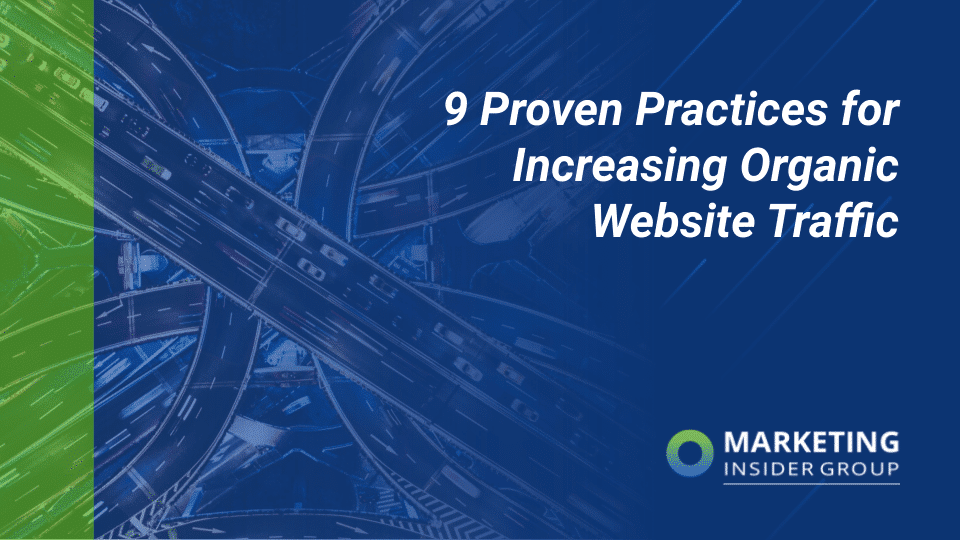
9 Proven Practices for Increasing Organic Website Traffic
In modern B2B marketing, a vibrant, engaging website isn’t just a bonus, it’s a necessity. A great website drives customer engagement, builds brand credibility, and can help foster a community around your products or services. But these benefits only come to light when your audience can easily find you in the crowded digital marketplace. And while paid ads and promotional partnerships are great ways to gain traction, organic website traffic is foundational to gaining visibility, enhancing engagement, generating leads, and driving conversions.
However, driving organic traffic isn’t as simple as launching a brand-new website and hoping your audience stumbles over it. Real organic growth requires a strategic approach and ongoing effort. To help get you started, here are 9 proven practices to propel organic website traffic.
1. Integrate Relevant Keywords
The foundation of a successful organic SEO strategy is keyword integration. By researching and using phrases your target audience is searching for, your website becomes more visible on search engines. Keyword research tools like Google Keyword Planner can help you find relevant keywords to integrate into your website’s content, meta titles and descriptions, and URLs.
For example, a B2B company specializing in data analytics software might identify keywords like “best data analytics software for businesses” or “enterprise data analytics solutions.” Once these keywords are identified, that company should integrate them into blogs, product descriptions, and other website content. These keyword updates increase the chances of your site appearing in search results for relevant queries, driving more organic traffic to your site.
2. Start a Blog
Blogs are proven tools for offering fresh, relevant content that keeps users returning to your site. They also provide ample opportunities for keyword integration and internal linking. Each new blog post is another web page that can rank in search engines and help increase your organic traffic.
For B2B companies, a blog is a cost-effective platform to showcase industry expertise, provide insights on market trends, and offer solutions to your target audience’s unique challenges. With proper planning of each post, your blog not only positions your company as a leader and innovator in your field but also gives potential clients a reason to frequent your site, fostering business relationships and potential opportunities. The more engaging and insightful your blog posts are, the more likely they will be shared, further amplifying your visibility and organic reach. And while blogs should abide by the rule of quality over quantity, consistency in posting can be as important as the content itself to promote organic growth.
3. Earn Quality Backlinks
Backlinks—links from other websites to yours—are a significant factor in search engine algorithms to rank the value and credibility of digital content. Relevant, quality backlinks from reputable websites build authority and trustworthiness, help with referral traffic, and improve the accuracy and speed of indexing your content. But not all backlinks are created equal. Excessive linking from low-quality or irrelevant sites can potentially harm your SEO, while high-quality backlinks can significantly boost it. It’s always better to focus on earning high-quality backlinks from reputable and relevant businesses in your industry, guest blogs, or by producing shareable content.
4. Optimize for Mobile
With over half of all web traffic coming from mobile devices, a mobile-friendly website should be considered mandatory. A mobile-optimized website that is responsive, loads quickly, and offers a seamless user experience helps improve brand trust. Responsive sites automatically adjust and adapt their layout, images, and functionalities to suit different devices and screen sizes. Fast and responsive websites help ensure your content looks good no matter how users view it, keep users engaged longer, increase the likelihood they’ll take desired actions like filling out a contact form or downloading a resource, and drive more organic traffic.
5. Update Outdated Content
Outdated content can hurt your search engine rankings and make users distrust your website. Regularly audit your content, update outdated information, and keep your website fresh and relevant. For example, many businesses still feature content or callouts focused on aspects of the COVID pandemic or a specific natural disaster that affected their industry—which may feel outdated or irrelevant to visitors, depending on the context of their site visit.
Staying vigilant to remove, refresh, and revitalize outdated content helps improve your search rankings, enhances user experiences, and builds trust. Producing “evergreen” content (content that remains relevant and valuable over a long period) is a great way to reduce the updates required, and offers a nice balance to more topical content.
6. Leverage Social Media Strategically
Social media channels are designed to help businesses grow, network, and build audiences, and taking a strategic approach to them can be highly effective in boosting organic traffic. Here are a few strategies to consider:
- Channel Selection: Not every social media channel will suit your business. Most B2B organizations might find more value in LinkedIn or Twitter, which are great for sharing industry insights, news, and detailed content. On the other hand, businesses that rely heavily on visual appeal, such as in the fashion, design, travel, or food industries, could experience more organic engagement from image-centric platforms like Instagram or Pinterest. The key is to choose platforms that align with your target audience and business goals.
- Quality Over Quantity: Sharing content for the sake of sharing can lead to low engagement, reduced visibility, and wasted resources. Instead, focus on producing high-quality content that your audience finds valuable. High quality means the content is relevant, accurate, comprehensive, unique, and professionally presented. These pieces can be thought-provoking articles, informative infographics, blogs, and videos.
- Consistent Branding: When your logos, color schemes, messaging, and tone of voice are consistent, it makes your business easily recognizable, irrespective of the platform. This consistency builds a sense of familiarity among your audience, which is vital in building trust and organic engagement. When audiences know what to expect from you, they’re more likely to engage organically, share, and follow through on CTAs. It’s important to note that your level of engagement and tone of voice are critical elements of a branded social media presence, and most businesses see better organic results when they actively respond to comments and like and share content from others.
7. Use Internal Linking Wisely
Internal links guide visitors to other pages on your website, keeping them engaged longer. They also help search engines understand the content and structure of your website, improving your SEO. For B2B companies, internal links can be used strategically to guide potential clients through your value proposition, showcase solutions and case studies, and share customer testimonials.
By effectively using internal linking structures, you can create powerful content silos that lead your visitors on a contextual journey that informs and builds trust, increasing the chances of conversion and boosting your organic traffic. During content reviews and updates, be sure to check for and remedy any broken links, as they can hamper the user experience and SEO.
8. Leverage Local SEO
Optimizing for local search is a must for any local business. Use local keywords, list your business on local online directories, and ask for customer reviews to boost your local SEO. For example, a healthcare technology company in Boston could incorporate keywords like “Boston healthcare technology” or “health tech solutions in Boston” into their content.
Make sure your business is also listed in local directories and on platforms that allow for customer reviews, as these channels can enhance your visibility in local search results, improve organic traffic and increase business opportunities within your local market. And no matter where you’re listed, ensure your business name, address, and phone number (NAP) are always consistent!
9. Optimize Page Loading Times
Slow-loading pages are a barrier to user engagement and can give an impression of unprofessionalism or poor technical capabilities, especially to potential B2B clients who value efficiency. Factors contributing to slow page loading times can include unoptimized images, excessive use of scripts, or a lack of browser caching. Furthermore, slow websites are often penalized in SEO ranking, as search engines prioritize sites that provide a “good” user experience marked by fast load times.
To counter this, regularly evaluate your website’s speed using tools like Google’s PageSpeed Insights. From there, you can optimize by compressing images, minimizing JavaScript and CSS files, leveraging browser caching, and considering a Content Delivery Network (CDN) for faster web content delivery. By ensuring your site loads quickly and runs efficiently, you enhance the user experience, encouraging visitors to stay longer, return more frequently, and possibly convert, all of which contribute to organic growth.
Get Started and Get Ranking!
In the vast ocean of the internet, standing out can seem like a monumental task, but these proven practices can help transform your website from a mere drop into a powerful wave, driving organic traffic and making an impact in your industry. Building organic traffic is a journey, not a destination, and as the digital landscape evolves, your strategies must adapt to keep pace. Stay curious, keep testing, and continue optimizing to navigate the ever-changing tides of SEO trends and algorithms.
If the prospect of charting these waters feels daunting, remember that you’re not alone—our team of marketing experts can help! Contact us to talk with our team about maximizing your organic traffic.






